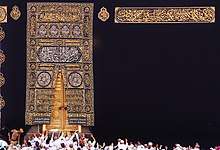Kiswah
Kiswah (Arabic: كسوة الكعبة, kiswat al-ka'bah) is the cloth that covers the Kaaba in Mecca, Saudi Arabia. It is draped annually on the 9th day of the month of Dhu al-Hijjah, the day pilgrims leave for the plains of Mount Arafat during the Hajj.[1] The term kiswah is Arabic for 'pall', the cloth draped over a casket.

Current
Every year, the old Kiswa is removed, cut into small pieces, and given to certain individuals, visiting foreign Muslim dignitaries and organizations. Some of them sell their share as souvenirs of the Hajj. In earlier times, Umar bin al-Khattab would cut it into pieces and distribute them among pilgrims who used them as shelter from the heat of Mecca.
The present cost of making the kiswa amounts to SAR 17,000,000 (~4,532,951.01 USD). The cover is 658m2 and is made of 670 kg of silk. The embroidery contains 15 kg of gold threads. It consists of 47 pieces of cloth and each piece is 14m long and 101 cm wide. The kiswa is wrapped around the Kaaba and fixed to its base with copper rings. The manually designed embroidery of the Quranic verses are slowly being aided by computers, thus increasing the speed of production.[2]
History
King Tubba Abu Karab As'ad of the Himyarite Kingdom clothed Kaaba for the first time, during the rule of the Jurhum tribe of Mecca.[1][3]
The Kiswah in the reign of Muhammad
Muhammad and the Muslims in Mecca did not participate in the draping of the Kaaba until the conquest of the city at 630 AD (7 AH), as the ruling tribe, Quraish, did not allow them to do so. When Mecca was taken by the Muslims, they decided to leave the Kiswah as it was until a woman lighting incense in the Kaaba accidentally set fire to the Kiswah. Muhammad then draped it with a white Yemeni cloth.[1]
Under the Kings
Many notable Kings have had their share of ruling over the Kiswah. Muawiyah I used to drape the Kaaba twice a year, along with the help of Abd-Allah ibn al-Zubayr, and Abd al-Malik. They brought the traditional silk covering into effect.
Al-Nasir, the Abbasid King, established the current practise of dressing the Kaaba with only one Kiswah at a time, superseding the former custom of allowing old Kiswah to accumulate one over the other. When Al-Nasir performed Hajj in 160 AH, he saw that the accumulated Kiswah could cause damage to the Kaaba itself, and therefore decreed that only one Kiswah should drape the Kaaba at any one time.
The King Al-Ma'mun, draped the Kaaba three times a year, each time with a different colour: red on the eighth of Dhu al-Hijjah, white gabati on the first of Rajab, and another red brocade on the twenty-ninth of Ramadan. Later on, Al-Nasir draped the Kaaba with green; both he and Al-Ma'mun disagreed on the frequent colour changes and switched to black, the only colour that has since been used for Kiswah. Black Kiswah supported by Tradition of Prophet to Mourning, some associated it with Battle of Karbala however saying of Prophet to wrap Kaaba with black cloth after 100 Years or before when events of Sorrow took start.
Location of manufacture
From the time of the Ayyubids, precisely during the reign of as-Salih Ayyub, the Kiswah was manufactured in Egypt, with material sourced locally as well as from Sudan, India, and Iraq.[4] The Amir al-Hajj (commander of the hajj caravan), who was directly designated by the sultans of the Mamluk, and later, Ottoman Empires, transported the Kiswah from Egypt to Mecca on an annual basis.[5] The tradition continued until 1927, when its manufacture was moved to Saudi Arabia.[4]
References
- "Qiswa, Kiswah & Kaaba". www.aulia-e-hind.com. Retrieved 2016-07-18.
- Islamic Voice article Kiswa: Dressing up God's Abode Vol 14-02 No:158 * FEBRUARY 2000 / Shawwal 1420H
- Ibn Hishām, ʻAbd al-Malik, -834. (1955). The life of Muhammad;. Ibn Isḥāḳ, Muḥammad, -approximately 768. London: Oxford University Press. ISBN 0-19-636034-X. OCLC 3705122.CS1 maint: multiple names: authors list (link)
- "Saudi Aramco World : A Gift from the Kingdom". www.saudiaramcoworld.com. Retrieved 2016-07-18.
- Dunn, Robert (1986), The Adventures of Ibn Battuta, a Muslim Traveler of the Fourteenth Century, University of California Press, p. 266, ISBN 9780520057715
-2.jpg)
